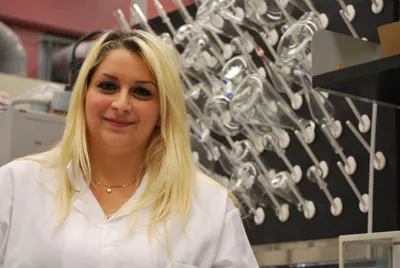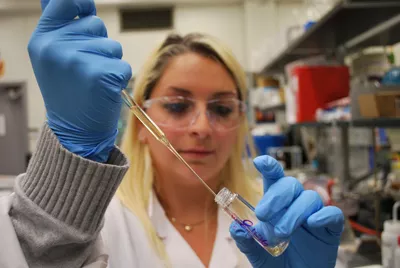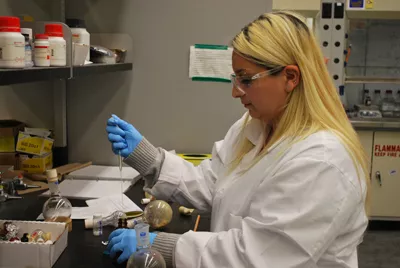
Cancer Sleuth: École Polytechnique award helps PhD student study disease
When Miriam Avadisian picked up her cell phone and learned that she had won a prestigious Canadian graduate award, her research group surrounded her and cheered so loudly that she could barely hear the details of her prize.
Avadisian is the 2012 recipient of the 1989 École Polytechnique Commemorative Award. The award, presented by the Canadian Federation of University Women (CFUW), commemorates the 14 women murdered at Montréal’s École Polytechnique and bestows $7,000 to recognize important doctoral-level studies relevant to women.
Avadisian, a PhD candidate in U of T Mississauga’s Department of Chemical and Physical Sciences, builds molecules to halt cancer. “I go home at night and think about what new molecules I can make, how I can ‘derivatize’ a particular molecule we’re working with, and how will it react in the body,” Avadisian says. “This is what you think about when you develop molecules that you hope could be a potential therapeutic for cancer.”

Stat3 exists in all human cells, turning genes on and off and playing a key role in the body’s growth, division and immune response. If Stat3 becomes persistently activated however, it can turn deadly—converting healthy, normal cells to cancerous ones that may lead to breast cancer, ovarian or prostate cancer, leukemia or lymphoma.
While a flurry of current research looks for ways to block Stat3 activation or interfere with its binding sites, Avadisian and her collaborators have found a unique approach to the problem of Stat3.
“My project uses a molecular glue to stick Stat 3 to the cell membrane,” Avadisian says. “The glue has a ‘key’ which binds to a specific pocket of Stat 3 and an ‘anchor’ which inserts into the cell membrane. Once Stat3 is stuck, it can’t mobilize in the cell. It’s a new way of targeting Stat3.”
Cancer cells, which rely on Stat3 to proliferate, soon die when the protein is unavailable, while healthy cells survive. Using a “protein-membrane anchor” to treat cancer would be “less toxic, less invasive and have fewer side effects” than chemotherapy, according to Avadisian.

“My dad often calls me and asks, ‘Did you find a drug for cancer?’” Avadisian says. “It’s awards like the École Polytechnique Commemorative Award that help me to avoid getting a part-time job which would take away from my time in the lab. It’s awards like this one that actually make that possible.”
